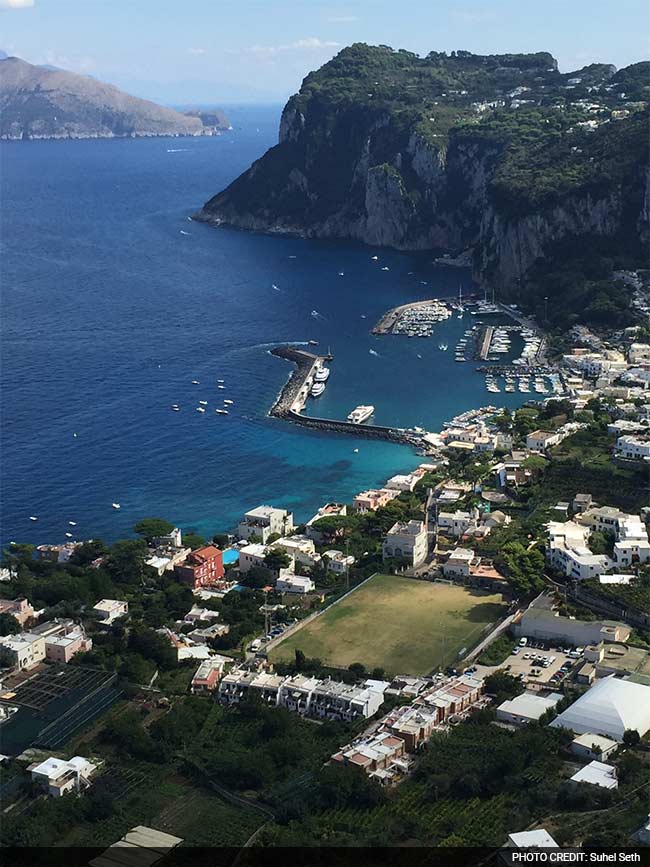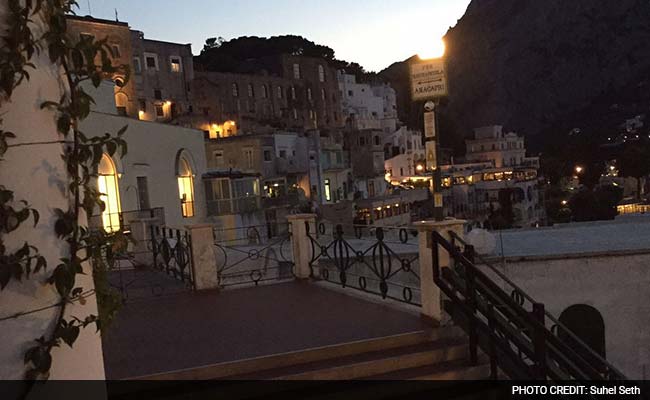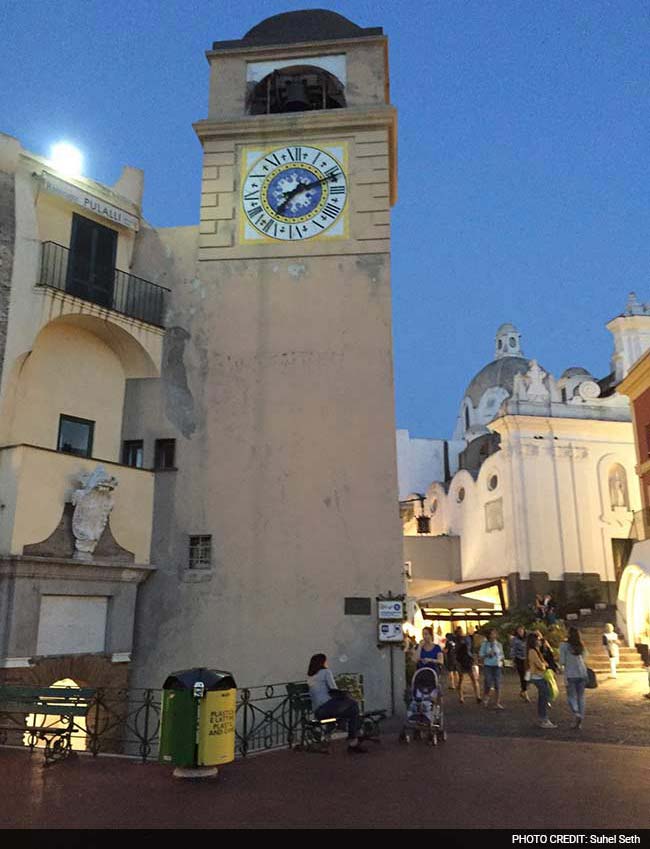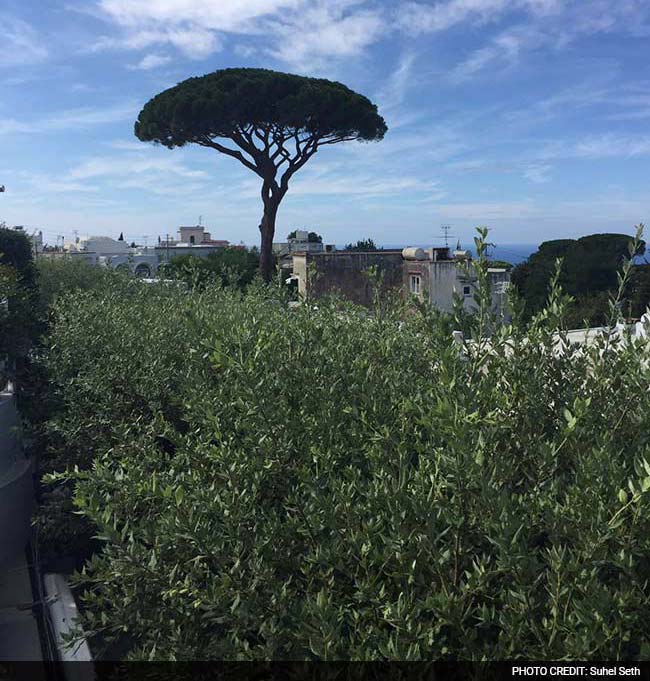
There is something magical about Capri. In fact there is always something magical about isles that dot fascinating oceans. In many ways, Capri could be described as a small jewel of a limestone island set on the outermost tip of the Sorrentine peninsula.
Once upon a time, two Roman emperors, Octavian Augustus and his successor Tiberius, co-opted Capri as their own personal Shangri-La. Fast-forward to the 1800s and the scene was set for the island's inevitable future as a haven for the rich and famous: everyone from artists to royalty began flocking to this paradise, drawn by its balmy clime and the electric glow of its blue grotto. But sunshine and grottos do not make an international A-list destination. What earned Capri its cachet, as one of the world's most cosmopolitan island destinations, is as much about its cornucopia of luxury hotels, chic boutiques and world-class restaurants, as its mythic lore and natural beauty.
 Capri is divided into the town of Capri on the eastern half of the island (a funicular railway connects the town centre to the port of Marina Grande where the ferries and hydrofoils arrive), and Anacapri, a less glamorous but far more pristine version of Capri. Anacapri is a small village (similar in size to the town of Capri), a quiet town with the sort of charm that makes you think you've been going there all your life. And once you do, you almost always return.
Capri is divided into the town of Capri on the eastern half of the island (a funicular railway connects the town centre to the port of Marina Grande where the ferries and hydrofoils arrive), and Anacapri, a less glamorous but far more pristine version of Capri. Anacapri is a small village (similar in size to the town of Capri), a quiet town with the sort of charm that makes you think you've been going there all your life. And once you do, you almost always return.
It was in October that I found myself winging my way to Naples, the nearest airport from where I got into this remarkable ferry to reach Capri and be received by the white-glove liveried butlers of the Capri Palace Hotel. I have to confess I almost always choose my destinations on the basis of the hotels they boast of. I had heard fairy tales of The Capri Palace Hotel; none of what I had heard even half-measured up to what I was about to experience.
Elegant hotels almost always have a remarkable legacy steeped in history and the Capri Palace and Spa Hotel is no exception.

In the eighth century B.C., a group of peaceful Greek settlers carved a long, steep staircase into the sheer rock face between the coastline and the higher reaches of the island of Capri. Anacapri - ana meaning above in Greek - was thus born, becoming the Acropolis of the island. To this day, the small town, with its narrow alleyways and dazzling white buildings standing in sharp contrast against the brilliant blue of the sea, preserves its typical Mediterranean architecture.
A large gate and palazzo were later built to protect the only access to the town.

Centuries later, Emperor Augustus, entranced by the spectacular beauty of the town, built one of his residences here, filling it with columns, decorative work, the finest marble and artworks. The Imperial Palace with its magical views overlooking the Gulf of Naples was later made even more sumptuous by Tiberius, who extended it beyond the city gate (where the Villa San Michele was built, now housing the Axel Munthe Museum) as far as the sight of Capodimonte on whose promontory, almost 2,000 years after the epoch of Augustus, the Capri Palace was reborn.
In August 1960, the Capri Palace & Spa Hotel was built at the foot of Mount Solaro with its magnificent views over the Gulf of Naples and Ischia Island. It immediately became a Mecca for discerning travelers. From the hotel, it takes only a few minutes to reach the little streets of the town of Anacapri.
 When his father passed away, Tonino Cacace inherited the family business at a very young age. With the utmost dedication and following in the footsteps of his father, he dramatically transformed the Hotel. In the space of just a few years, it became the favorite destination of famous personalities from the worlds of the arts, business, and entertainment.
When his father passed away, Tonino Cacace inherited the family business at a very young age. With the utmost dedication and following in the footsteps of his father, he dramatically transformed the Hotel. In the space of just a few years, it became the favorite destination of famous personalities from the worlds of the arts, business, and entertainment.
In 2001, after a major restyling that strictly respected the classic Mediterranean design of the building and which gave the hotel the appearance of a noble palace, the hotel became part of the prestigious Leading Hotels of the World group. With its stone floors, columns, arches and vaulted ceilings, every element is a reminder of a glorious past that seems to come to life in its entire splendor. The travertine baths, the warm tones of the fabrics, and the sumptuous white-and-gold decor give each room an understated elegance that combines with the feeling of a deliciously warm welcome. Reminiscent of the most beautiful Roman coastal villas, some of the rooms overlook an internal garden with a private swimming pool.
As an inveterate traveller, I try and avoid hotels that belong to or are corporations for I have always believed the quintessential hotelier is, in effect, a humble inn-keeper, and the special magic that an inn-keeper brings is always far better than some standardized operating manual. Great hotels always follow passion rather than process. The other fine trait about the Capri Palace & Spa Hotel is that it is small. With just 72 rooms, it makes an understatement, and you have no loud tourists swarming the breakfast room and other guest spaces. I swam alone without having to dodge errant swimmers in the pool.

Having arrived in the afternoon from Naples, I settled down for a Bloody Mary which was served to me at the Ragu Bistrot, a casual restaurant overlooking the Gulf of Naples: and here I was surrounded by history and overlooking a place which, to this day, reminds you of the many wars that were fought to preserve culture and legacy as most wars should be. I then settled in to my suite, which had its own heated plunge pool with yet again breathtaking views of the Gulf and the town around the hotel. After a fine siesta and some coffee, I was ready to explore the island. So off I went to visit churches and flea markets, sample some gelato: all with the verdant settings of a place where time stood still. The unhurriedness of Capri is soothing to say the least. But then when you are in Capri, all you need to do is eat, imbibe and walk. The cobble-stoned streets have their own sounds and carry their own footprints of time.
I came back to the hotel to dine in their 2-Michelin stars restaurant: L'Olivo, which, by the way, is the only Michelin restaurant on the whole island. The meal was heavenly and the wine had to be special since it emerged from La Dolce Vite, the hotel's wine cellar which boasts of more than a thousand labels. From dinner, it was time to get back to the terrace and see an entire island light up fired by stars in the sky.

The next day was a day for pampering and gentle rest which is why I headed to the hotel's Beauty Farm which is amongst the finest spas you will ever visit. I tried many treatments, but their Leg School treatment is out of this world. I was then told that this is Europe's most highly-regarded medical spa. Post my spa treatments, I visited the White Museum which is an exclusive art collection, enabling you a refined glance at Italian and contemporary art.
The following day was a lazy one at sea: the hotel provides you with a speedboat in which everything you need for sustenance is packed. The waters of the Gulf of Naples are a serene blue and I spent the entire day at sea. Imagining the trials and tribulations of early seafarers and the beauty they were surrounded with whenever out at sea. I then went to the Il Riccio Beach Club & Restaurant owned by the same family that owns the Capri Palace & Spa Hotel and it was here that in an informal but delightful setting that I heard Pavarotti and Borelli whilst digging into my pizza sprinkled with the finest buratta I have ever had. Washed down with some desert wine, it was time to get back to the hotel and prepare for a departure the following morning.
I have too many memories of the little sights and sounds of Capri to be able to capture them in prose and to Capri I will return. Not once but every year.
(Suhel Seth is Managing Partner of Counselage: India's only strategic brand advisory. He would like to clarify that no part of the trip was paid for by any of the establishments mentioned in the article.)
Disclaimer: The opinions expressed within this article are the personal opinions of the author. The facts and opinions appearing in the article do not reflect the views of NDTV and NDTV does not assume any responsibility or liability for the same.
Once upon a time, two Roman emperors, Octavian Augustus and his successor Tiberius, co-opted Capri as their own personal Shangri-La. Fast-forward to the 1800s and the scene was set for the island's inevitable future as a haven for the rich and famous: everyone from artists to royalty began flocking to this paradise, drawn by its balmy clime and the electric glow of its blue grotto. But sunshine and grottos do not make an international A-list destination. What earned Capri its cachet, as one of the world's most cosmopolitan island destinations, is as much about its cornucopia of luxury hotels, chic boutiques and world-class restaurants, as its mythic lore and natural beauty.

It was in October that I found myself winging my way to Naples, the nearest airport from where I got into this remarkable ferry to reach Capri and be received by the white-glove liveried butlers of the Capri Palace Hotel. I have to confess I almost always choose my destinations on the basis of the hotels they boast of. I had heard fairy tales of The Capri Palace Hotel; none of what I had heard even half-measured up to what I was about to experience.
Elegant hotels almost always have a remarkable legacy steeped in history and the Capri Palace and Spa Hotel is no exception.

In the eighth century B.C., a group of peaceful Greek settlers carved a long, steep staircase into the sheer rock face between the coastline and the higher reaches of the island of Capri. Anacapri - ana meaning above in Greek - was thus born, becoming the Acropolis of the island. To this day, the small town, with its narrow alleyways and dazzling white buildings standing in sharp contrast against the brilliant blue of the sea, preserves its typical Mediterranean architecture.
A large gate and palazzo were later built to protect the only access to the town.

Centuries later, Emperor Augustus, entranced by the spectacular beauty of the town, built one of his residences here, filling it with columns, decorative work, the finest marble and artworks. The Imperial Palace with its magical views overlooking the Gulf of Naples was later made even more sumptuous by Tiberius, who extended it beyond the city gate (where the Villa San Michele was built, now housing the Axel Munthe Museum) as far as the sight of Capodimonte on whose promontory, almost 2,000 years after the epoch of Augustus, the Capri Palace was reborn.
In August 1960, the Capri Palace & Spa Hotel was built at the foot of Mount Solaro with its magnificent views over the Gulf of Naples and Ischia Island. It immediately became a Mecca for discerning travelers. From the hotel, it takes only a few minutes to reach the little streets of the town of Anacapri.

In 2001, after a major restyling that strictly respected the classic Mediterranean design of the building and which gave the hotel the appearance of a noble palace, the hotel became part of the prestigious Leading Hotels of the World group. With its stone floors, columns, arches and vaulted ceilings, every element is a reminder of a glorious past that seems to come to life in its entire splendor. The travertine baths, the warm tones of the fabrics, and the sumptuous white-and-gold decor give each room an understated elegance that combines with the feeling of a deliciously warm welcome. Reminiscent of the most beautiful Roman coastal villas, some of the rooms overlook an internal garden with a private swimming pool.
As an inveterate traveller, I try and avoid hotels that belong to or are corporations for I have always believed the quintessential hotelier is, in effect, a humble inn-keeper, and the special magic that an inn-keeper brings is always far better than some standardized operating manual. Great hotels always follow passion rather than process. The other fine trait about the Capri Palace & Spa Hotel is that it is small. With just 72 rooms, it makes an understatement, and you have no loud tourists swarming the breakfast room and other guest spaces. I swam alone without having to dodge errant swimmers in the pool.

Having arrived in the afternoon from Naples, I settled down for a Bloody Mary which was served to me at the Ragu Bistrot, a casual restaurant overlooking the Gulf of Naples: and here I was surrounded by history and overlooking a place which, to this day, reminds you of the many wars that were fought to preserve culture and legacy as most wars should be. I then settled in to my suite, which had its own heated plunge pool with yet again breathtaking views of the Gulf and the town around the hotel. After a fine siesta and some coffee, I was ready to explore the island. So off I went to visit churches and flea markets, sample some gelato: all with the verdant settings of a place where time stood still. The unhurriedness of Capri is soothing to say the least. But then when you are in Capri, all you need to do is eat, imbibe and walk. The cobble-stoned streets have their own sounds and carry their own footprints of time.
I came back to the hotel to dine in their 2-Michelin stars restaurant: L'Olivo, which, by the way, is the only Michelin restaurant on the whole island. The meal was heavenly and the wine had to be special since it emerged from La Dolce Vite, the hotel's wine cellar which boasts of more than a thousand labels. From dinner, it was time to get back to the terrace and see an entire island light up fired by stars in the sky.

The next day was a day for pampering and gentle rest which is why I headed to the hotel's Beauty Farm which is amongst the finest spas you will ever visit. I tried many treatments, but their Leg School treatment is out of this world. I was then told that this is Europe's most highly-regarded medical spa. Post my spa treatments, I visited the White Museum which is an exclusive art collection, enabling you a refined glance at Italian and contemporary art.
The following day was a lazy one at sea: the hotel provides you with a speedboat in which everything you need for sustenance is packed. The waters of the Gulf of Naples are a serene blue and I spent the entire day at sea. Imagining the trials and tribulations of early seafarers and the beauty they were surrounded with whenever out at sea. I then went to the Il Riccio Beach Club & Restaurant owned by the same family that owns the Capri Palace & Spa Hotel and it was here that in an informal but delightful setting that I heard Pavarotti and Borelli whilst digging into my pizza sprinkled with the finest buratta I have ever had. Washed down with some desert wine, it was time to get back to the hotel and prepare for a departure the following morning.
I have too many memories of the little sights and sounds of Capri to be able to capture them in prose and to Capri I will return. Not once but every year.
(Suhel Seth is Managing Partner of Counselage: India's only strategic brand advisory. He would like to clarify that no part of the trip was paid for by any of the establishments mentioned in the article.)
Disclaimer: The opinions expressed within this article are the personal opinions of the author. The facts and opinions appearing in the article do not reflect the views of NDTV and NDTV does not assume any responsibility or liability for the same.
Track Latest News Live on NDTV.com and get news updates from India and around the world

